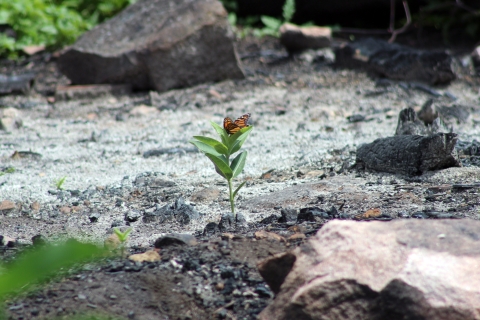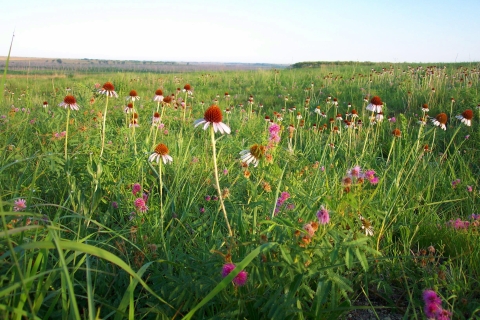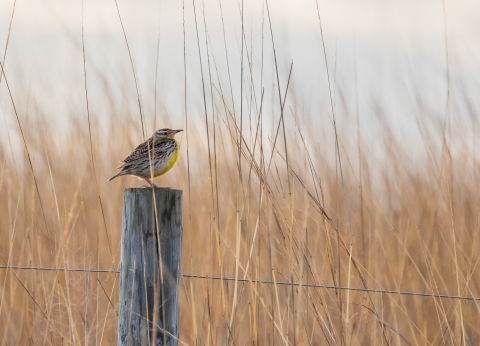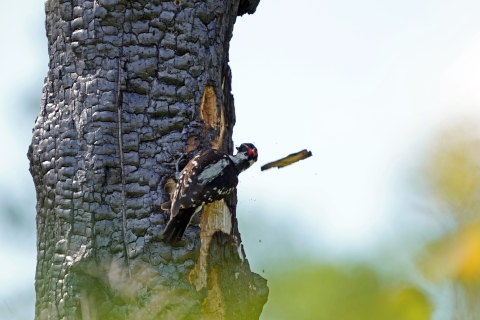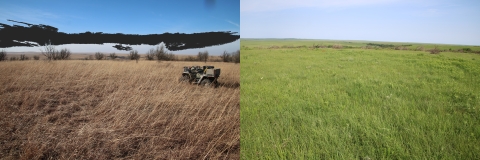The red-orange fingers of fire are rarely a welcome sight – especially when they’re racing across precious landscapes and threatening homes and communities – but there are times when fire is one of the most useful tools we have to maintain and preserve the health of ecosystems. While it may seem counterintuitive, planned ignition – otherwise known as prescribed fire – has long been used to keep grasslands healthy.
The U.S. Fish and Wildlife Service (Service) uses fire to manage the lands and ecosystems we care for, resist the spread of invasive species invasive species
An invasive species is any plant or animal that has spread or been introduced into a new area where they are, or could, cause harm to the environment, economy, or human, animal, or plant health. Their unwelcome presence can destroy ecosystems and cost millions of dollars.
Learn more about invasive species , provide healthy habitats for wildlife, and support the natural cycle of nutrients that soils need to stay healthy. Across the Central Grasslands, fire is an important tool for restoring and preserving natural grasslands, which are essential to the survival of thousands of species that rely on the grasses and wildflowers of healthy prairies. However, the use of fire as a tool to manage grasslands far predates its use by the Service.
Native Americans have had a close relationship with fire for millennia. Many different groups of Indigenous peoples used various techniques of what we now call prescribed fire to maintain landscapes across the continent. By purposefully burning areas at specific times and intensities, they were able to produce habitat for species they preferred, sustain the long-term health of this land for thousands of years, and prevent the massive wildfires we see today.
Frank Kanawha Lake, a research ecologist with the U.S. Department of Agriculture (USDA) Forest Service, shared his perspective with environmental archaeologist Christopher Roos:“[Cultural burning] links back to the tribal philosophy of fire as medicine. When you prescribe it, you’re getting the right dose to maintain the abundance of productivity of all ecosystem services to support the ecology in your culture.”
Tree rings dating back thousands of years can tell the story of how early colonial settlers caused a change in the North American fire regime. As Native Americans were pushed out of and taken from the lands, the landscape was deprived of a longtime steward. Hundreds of years of fire suppression has caused a notable change from historical patterns on the landscape, driving the increase of devastating grassland wildfires we have seen over the last two decades. (See America’s New Wildfire Risk Goes Beyond Forests and Surging wildfire activity in a grassland biome to learn more.) Today's landscapes have been so charged with fuels and fire-susceptible species; any fire that starts has the capacity to become particularly catastrophic.
Ecological Benefits of Fire
Some landscapes need fire to survive. Prescribed fires remove excess fuels from the landscape, which plays a major role in nutrient cycling. Fire can also be a catalyst for important changes by removing invasive plants, restoring natural habitats, and contributing to the natural carbon cycle.
Many ecosystems reset after a fire, giving native plants much-needed space and time to recover — not just from the fire, but from potentially harmful overgrowth of invasive species and local native competition that were removed by the fire.
By using prescribed fires, land and fire managers can safely store nutrients in the soil while propagating seed dispersal of native plants, which, in turn, allows native species like prairie wildflowers and even carnivorous plants to flourish. There are many ways in which wildlife – like whooping cranes and sandhill cranes, Mississippi kites, raptors, marsh rabbits, and gopher tortoises – benefit from fire, including enjoying the fresh, nutrient-rich vegetation that emerges afterwards and the reduction of invasive species.
Without fire, habitats can become overgrown, creating more aggressive competition for resources such as space, water, and sunlight among native and non-native plants. Over time, unchecked overgrowth leads to a gradual transition of habitat, which may no longer be able to support native plants and wildlife. These types of events are happening in many prairies across the United States, as woodland areas and forests replace native grassland habitat. Greg Kramos, a private lands biologist for the Service, says that some shorebirds, such as upland sandpipers, need wildfire to clear invasive trees from tallgrass prairies in America’s Great Plains. “No fire, no upland sandpipers,” he says. “Restoring fire to grasslands is critical for migrating shorebird populations. Buff-breasted sandpipers and American golden plovers use burned pastures for food during migration.”
The Karner blue butterfly is another such example. Protected as endangered under the federal Endangered Species Act in 1992, this colorful butterfly is dependent on wild lupine plants for survival. Without natural fires, however, forests grow where the lupine once did, and the butterflies can’t survive. Other animals, particularly grassland birds, have been observed to leave an area once a single tree encroaches on their habitat. There are many theories as to why this happens, but one leading thought is that trees are useful hiding places for predators.
The Threat of Encroachment
Today, the incorporation of fire as a tool for landscape management is more important than ever. Throughout the Central Grasslands, the spread of invasive species – including non-native grasses, weedy forbs, trees, and shrubs – is threatening the balance and future of this critical ecosystem. As a result of these invasive species, as well as land conversion, approximately 62% of the native grassland biome in North America has been lost, which has contributed to a 53% reduction in grassland bird populations since 1970 —more than 720 million birds.
Like the Indigenous stewards long before them, the Service’s land managers understand the natural solution that fire provides to keep the grass in grasslands. Woody plant encroachment, a term used to describe the expansion of trees and shrubs into native grasslands, is a serious threat for the Central Grasslands, and it is a threat that is concerning scientists and land managers across the country. While some woody growth can have cultural or economic value, what we are referring to here is the large-scale expansion of woody growth into grasslands.
The Central Grasslands, home to thousands of animals, insects, and plants, are shrinking. The historical expanse of the Central Grasslands has declined by 62% from its historic range due to a number of factors, including invasive species. As more trees and shrubs invade grasslands, pushing out native grasses and forbs, the grassland habitat is transformed into woodland or taken over by undesirable species.
The idea that trees could be invasive may seem surprising or counterintuitive – indeed, planting trees can be a significant and inspiring action for citizens wanting to care for the earth – but just as forests play an important ecological role, so too do grasslands. Thousands of species are native to these grassy habitats, and when native habitat disappears, the plants, animals, and insects that live there disappear, too. It is imperative that our remaining grasslands are conserved for the sake of the life that flourishes on this landscape.
Grasslands also provide additional benefits and are keystones for social, economic, and ecological systems around the world. Without grasslands, the world would have to adjust to the loss of millions of pollinators – which are critical for global food security – as well as birds, flora, and fauna. Losing grasslands can also have a negative effect on the economic security of rural communities. Industries like agriculture, recreation, and tourism play a major role in the local economies of many grassland communities - and these communities often have national and global impacts, particularly in food security.
Unlike trees, grasses store water, carbon, and other nutrients deep in their root system, keeping soils nutrient-rich and healthy. Worldwide, grasslands store about one third of global carbon stocks, and 90% of that is stored underground. As the world grapples with changes and disruptions to climate patterns, the importance of storing carbon will continue to increase – making grasslands a vital ecosystem that must be conserved.
Social Acceptance of Fire
Throughout the Central Grasslands, fire is an invaluable tool used to push back invasive species and help reclaim the native grasslands that have historically covered this region. In some places across the Central Grasslands, a fire culture has developed through generations of landowners passing down this way of life – and nowhere is this more apparent than in the Flint Hills of Kansas and Sandhills of Nebraska, where fire on the landscape is an integral part of everyday life.
| Image Details
Roger Wells, Tallgrass Legacy Alliance Coordinator and retired Wildlife Biologist, shares a story that has become a Flint Hills legend:
“In the Flint Hills, there is a story that has been repeated and retold for 80+ years, passed down from generation to generation, sustaining a time-honored fire culture among landowners. Now, whether the individual about whom the story is told is one person or a composite of several old-time ranchers, only the most elderly of Flint Hills residents could tell you. As the story goes, there was an elderly rancher in the 40s and 50s who owned considerable acreage along a 30-mile stretch of the Flint Hills. During the burning season, he would notify his neighbors when he was preparing to burn – and then he would drive down the gravel roads, tossing lit matches from his truck.
“Now, this wasn’t all his land – his land was scattered along the route – but the landowners in the area would use a phone tree to rally everyone, and that’s when you’d see landscape-scale burns across the Flint Hills, with dozens of landowners letting the fires go until they reached natural firebreaks, usually rivers and streams. Of course, this was a long time ago when there were few houses and homesteads in the Flint Hills, and those who did live there were prepared for spring burn season, but this story really highlights what fire culture was like at the time.”
While land managers don’t toss lit matches form their trucks these days, whether staff on a National Wildlife Refuge or private landowners, they are working together to rebuild a fire culture. At Kirwin National Wildlife Refuge in Kansas, for example, 200 miles from the Flint Hills, Service managers and biologists are using fire to remove excessive amounts of organic plant material, invasive species, and woody encroachment to restore and maintain healthy, sustainable prairies. Not only does fire improve the diversity of flora and fauna on the refuge, but it can also mitigate negative impacts and safety concerns of large-scale wildfire events. Specifically, fire is most effective when utilized with other management tools such as grazing, haying, mechanical tree removal, and invasive species chemical application treatments. The Refuge also partners with other agencies, local communities, Prescribed Burn Associations (PBAs), and the National Interagency Prescribed Training Center to promote the use of prescribed fire on the landscape.
| Image Details
In the Sandhills of Nebraska, the world’s most intact prairie, private landowners and Refuges managers at Valentine, Fort Niobrara and Crescent Lake National Wildlife Refuges are using fire to manage for specific grasses, improve habitat for grassland birds and migratory waterfowl, and battle eastern red cedar expansion. Fire is particularly important after cutting cedar – within 3-5 years after cutting, hundreds of tiny seedlings start resprouting, and prescribed fire is best management tool to address the resprouts. Landowners across the Sandhills have created their own PBAs to address the spread of red cedar at their local level, allowing landowners to work collaboratively across fence lines to do larger landscape-level fires.
Support for fire culture isn’t universally accepted across the Central Grasslands. In fact, there are many places in the Central Grasslands where the use of fire as a land management tool is generally dismissed. There are partners, NGOs, and stewards of the land working to change this narrative through landowner-led social change, however, they often face resistance both from their peers, as well as from the organizations that control funding.
“Prescribed burning for fuels reduction often receives greater funding compared to ecosystem restoration or land management,” says Dirac Twidwell, professor and rangeland ecologist with the University of Nebraska-Lincoln’s large-scale rangeland conservation lab, and science advisor for Working Lands for Wildlife, an approach of USDA’s Natural Resources Conservation Service (NRCS). “But fuels reduction without ecosystem management is a reactive – albeit important – approach that fails to prevent the build-up of volatile fuels. Instead, the full value of prescribed fire occurs when it is a long-term fixture to manage ecosystems. This is when we see land management actions mitigate several large-scale problems resulting from woody encroachment in grasslands, including heightened wildfire danger, loss of forage production, the collapse of grassland wildlife, reduced water quantity and quality, increased vector-borne disease risk and even reduced public school funding. It is extraordinarily difficult to restore these ecosystem services at large scales, and this is why we continue to see more grassroots efforts to restore fire as a critical ecosystem process early-on and before these types of problems occur.”
David Toledo, Rangeland Management Specialist with the Agricultural Research Service of the U.S. Department of Agriculture, believes the solution to this problem may have more to do with community than it does with risk. More specifically, in a paper published in 2013, he and his colleagues suggested that PBAs – like the ones in Nebraska, Kansas, Oklahoma and Texas – play a bigger role in social acceptance than previously thought. Barriers like lack of skill, knowledge, and access to equipment may be a significant source of landowner resistance to fire as a management tool. However, PBAs can help landowners overcome these barriers. It is the hope of many conservationists in the Central Grasslands that increasing access to education, training, and resources will enable fire culture to take root and grow in these places where it is needed most.
To learn more about fire and grassland ecology:
- Surging wildfire activity in a grassland biome
- Advancing Fire Ecology in 21st Century Rangelands
- The role of prescribed burn associations in the application of prescribed fires in rangeland ecosystems
- Grassland soil carbon sequestration: Current understanding, challenges, and solutions
- Extreme Fire Research - Twidwell Lab at the University of Nebraska-Lincoln Department of Agronomy and Horticulture
Just as with conservation, this story was a product of collaboration with our partners and colleagues across the country.
Written by Christina Stone and Gigi Otten, Public Affairs Specialists with the U.S. Fish and Wildlife Service, in collaboration with John Carlson, Katie Nuessly, Evan Monnett, Chad Christiansen, Cami Dixon, Brad Krohn, Matt Sprenger, Greg Kramos, Beth Ross, Mike Disney, Ian Lane, Laura Jenkins, and Tate Fischer of the U.S. Fish and Wildlife Service, David Toledo of the U.S. Department of Agriculture Agricultural, Research Service, Julia Debes and Greg Peters with the U.S. Department of Agriculture Working Lands for Wildlife, Lisa Baril with the Northern Great Plains Joint Venture, and Wenfei Tong with Cornell University
With special thanks to Roger Wells and Dirac Twidwell



